Does Sedona Have a Healthy Economy?
By Mark TenBroek
Sedona Arizona – We have been hearing that the local economy is heading toward a recession and that the local business situation is dire. So it is important to look back and see how the economy has performed over the past few years and how this compares with the current economic situation. This can tell us where we are likely headed and how we may be able to adjust course.
local business situation is dire. So it is important to look back and see how the economy has performed over the past few years and how this compares with the current economic situation. This can tell us where we are likely headed and how we may be able to adjust course.
It is also important to understand that we have been through a significant upset in the local, national, and international economies. This article will focus on the local economic changes.
In the spring of 2020 Sedona entered a period of almost complete stoppage of much of the local economy during the pandemic, as shown in the photo of Uptown below. The Federal government knew that there needed to be an adjustment and financial assistance came to many citizens to help reduce the impact with direct payments to taxpayers.
Once the country started to exit from the pandemic shutdown it was clear that many people were looking for options for vacations and since international travel was severely restricted, many people took their cars and began exploring the country given the proximity of Sedona to Phoenix and California.
Components of the Local Economy
First we must consider the components of the local economy. This is important because this economic activity fuels local employment and also pays for the many services provided by the City of Sedona. Following are the general categories of the local economy:
- Sales and Bed Taxed Items – Much of the local economy depends on sales that fit in these categories, with the most significant being Retail, Restaurants and Bars, Lodging, and Amusement. There are also several other smaller categories including Construction, Leasing, and Communication/Utilities.
- Grocery – This includes the sale of non-prepared food items in Grocery stores. While grocery stores do sell taxable items in the retail category, they primarily are selling items that are not taxed.
- Fuel – Fuel is not taxed using sales tax, but there are state and federal fuel taxes on a per gallon basis. A portion of the state fuel tax is returned to local communities.
- Real Estate – Another element of the local economy is the sale of real estate, which includes vacant property, completed residences and businesses. There is no sales tax charged for the sale of property in Arizona, but the contracting used to construct structures is taxed.
- Health Care – Another non-taxed item is health care, such as dental and medical services.
Sales and Bed Taxed Items
Items that are taxed require reporting to the Arizona Department of Revenue (ADOR) and the use of an Arizona Transaction Privilege Tax (TPT) license. Taxes are collected by the different vendors for both state and local sales taxes and bed taxes and are then provided to ADOR. ADOR accumulates these taxes and sends these tax proceeds weekly to Sedona along with an accounting of how much was generated by each business category. In addition, the increase in traditional lodging and STRs available outside of Sedona may reduce the use of traditional lodging inside Sedona City limits.
Total sales and bed taxes have been presented on the City of Sedona website on a monthly basis for many years as is summarized on the following graphic for the past 20 years. It has been fairly typical that there are two peaks annually in the economic activity in Sedona, primarily distributed between the Spring and Fall peak periods. It has also been common for this data to be plotted by month for several years to allow the comparison by month to these prior years months.
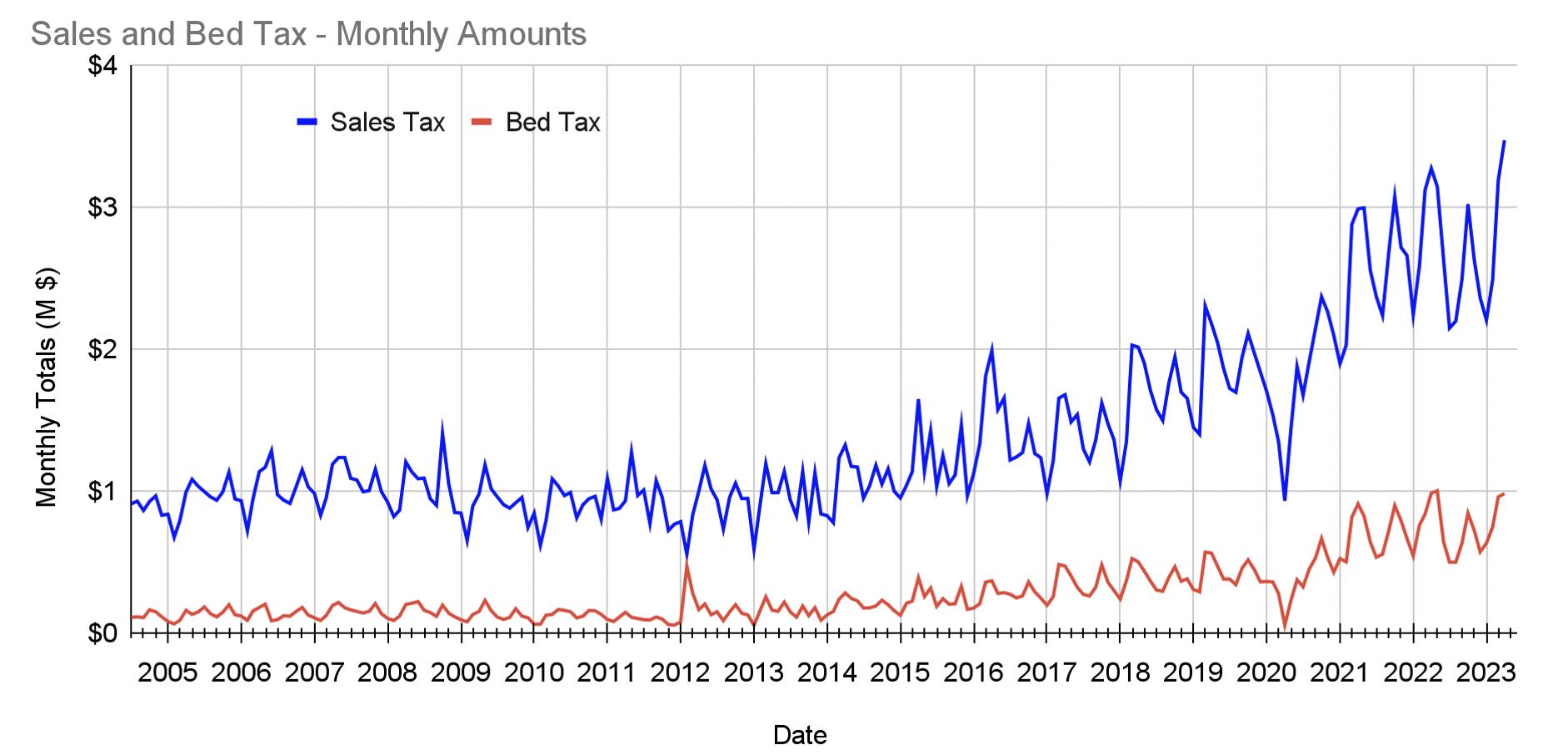
It is often useful to look at this type of cyclical data using a moving average or moving total. A 12-month moving total simply sums the prior 12-months to provide a running total. This approach tends to remove the seasonal variation and shows the more significant underlying changes that are occurring while also showing the total economic sales and bed tax values as time progresses.
The following graph shows this 12-month moving total taxable economy for Sedona for all taxable items by using the sales and bed tax rates in use over this period. From this graph one can see that the taxable sales alone (blue line) in Sedona exceeded $900 Million over the past year. The component of this associated with lodging at $250 Million (red line) is almost 28% of the local taxable economy. It should also be remembered that there are also non-taxable sales such as food, fuel, healthcare, and real estate that add to the local economic activity.
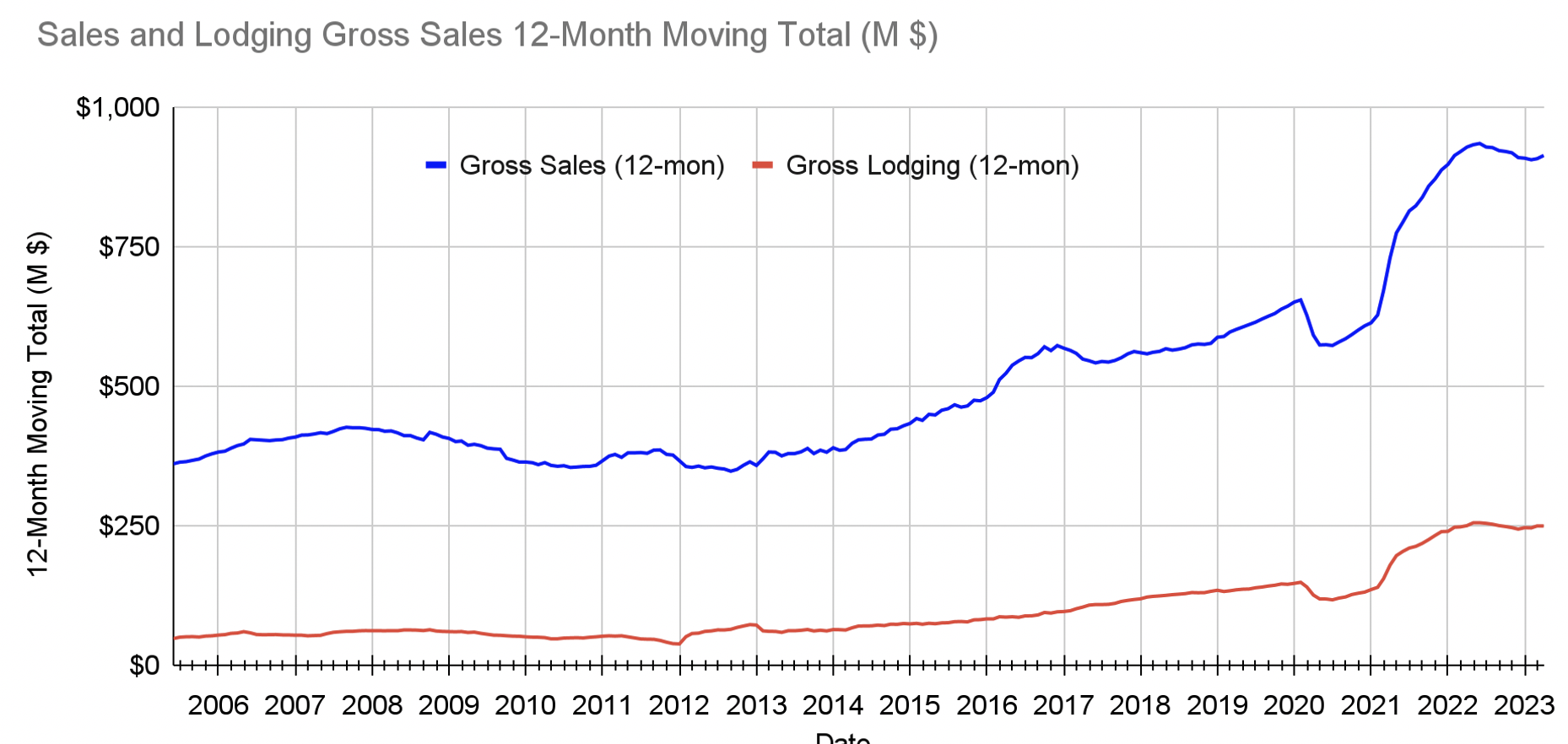
From this graph one can see that after the financial crisis of 2008 when Sedona had a dramatic drop in construction of homes, there was also a decrease in the local economy, likely because Phoenix and Las Vegas saw similar significant reductions in their local economies. Beginning in 2013 there was an upward trend in the overall local economic activity. These increases in the local economy continued until the pandemic struck in early 2020. This was followed by an historic rebound in local economic activity in the spring of 2021 that dwarfed prior increases, likely due to reduced vacation options for many nearby residents as they all seemed to travel to our community. This economic activity peaked in early 2022.
When the local economy overheated in 2020-2021, the City Council called for a suspension of Destination Marketing by the Chamber of Commerce. They understood that the significant growth seen post pandemic was not sustainable nor perhaps desirable within a community with limited transportation infrastructure to manage the rush of additional tourism vehicles as well as jeep and ATV vehicles.
The graph above also shows a more recent change in the trajectory of the taxable sales in Sedona. The past few months show a stabilization in the economy which could be attributed to a number of national and international factors. It must be remembered that the post pandemic increase in the local economy was fueled by many regional travelers and for the most part airline and foreign travel was restricted so many took to their cars.
Influences on Sedona Economy
Another way to look at these changes in the economy is to look at the economic activity and compare this to the annual inflation rates that are calculated for the entire country. The following graph shows our annual gross taxable sales and lodging sales, and compares them to the rate of compounded inflation for two different time periods and what the community should expect with the national inflationary ups and downs of the overall economy.
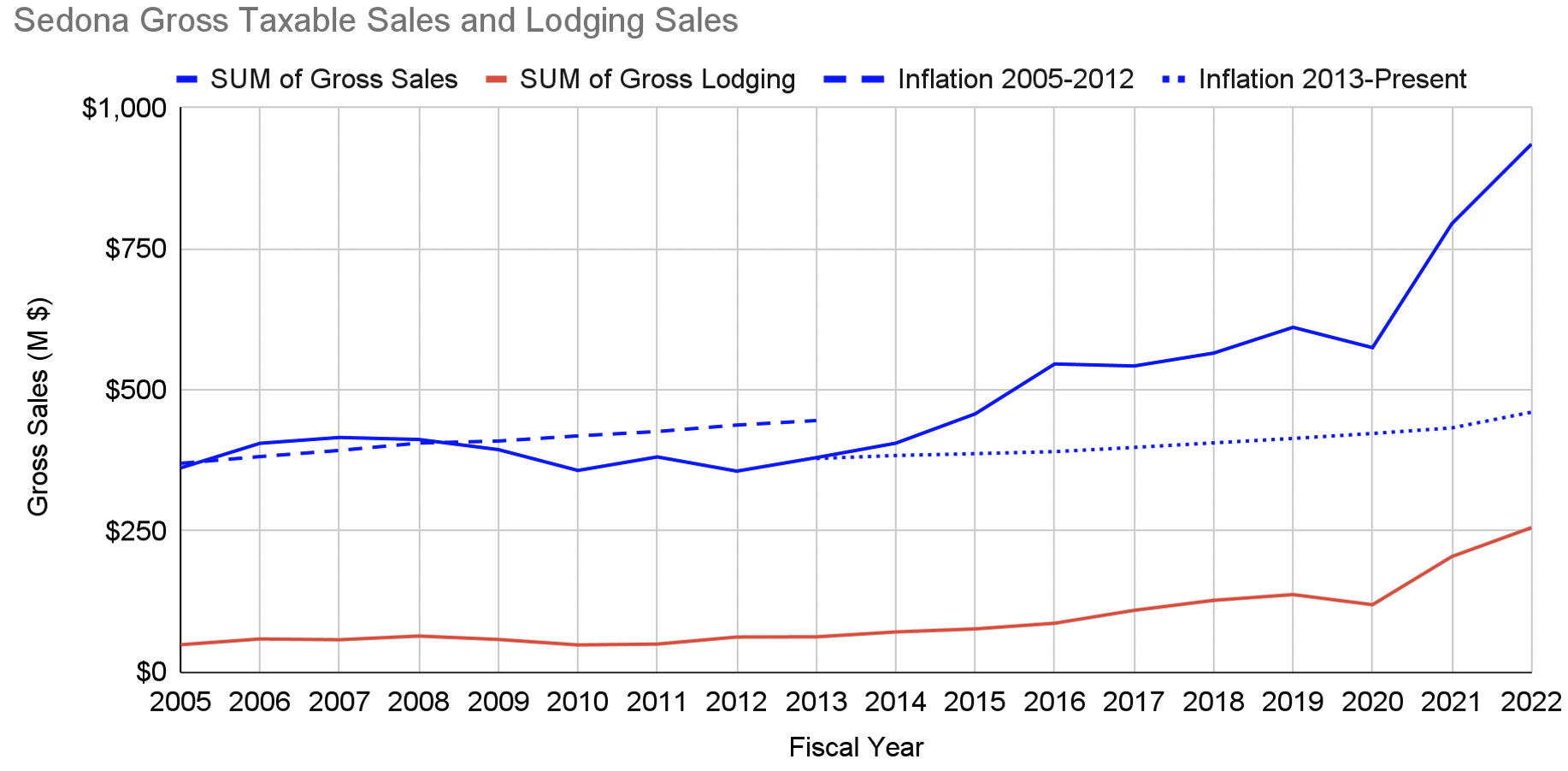
From 2005 until 2013 the local economy under performed compared to the overall US economy using the Consumer Price Index (CPI) inflation as an indicator of that growth. This was likely due in part due to the 2008 financial crisis affecting the ability of many citizens to travel and spend their disposable income coming and staying in Sedona.
In 2013, however, there was a significant increase in local economic activity compared to prior years. One could tie this to the beginning of the contract with the Sedona Chamber of Commerce and Tourist Bureau “Destination Marketing” to make Sedona a place that tourists want to visit and spend their disposable dollars, but clearly there are many other factors that influenced travel to the area including the growth of Phoenix. As well, in 2016 the State of Arizona passed a law prohibiting local communities from banning short-term rentals (STRs) or enacting their own restrictions and regulations.
From that point on, one can see an almost exponential increase in both the total taxable sales and the spending on lodging compared to inflation, with the 2020 downward blip that was easily overcome in 2021. Clearly Sedona needs to assess whether this type of exponential growth is really healthy for the community, or if a more controlled local economy is better for businesses and residents alike.
Local Taxable Sales by Category
After 2014 more detailed information was made available by Sedona on the different taxable sales categories shown in the graph below. This graph shows the local gross taxable sales by the categories listed for this period of time, again using the 12-month moving totals approach to understand the longer term trends in these annual sales.

From this graph a number of general observations can be made as follows:
- Retail – Retail is the largest overall sales category and there has been a significant increase in retail spending in Sedona and a significant recovery in sales since the pandemic. This includes local sales as well as mail order sales such as from Amazon.com. These sales have plateaued and are slightly decreasing in the past year.
- Hotel/Motel – Over this period there has been no significant increase in the number of hotel rooms in Sedona, but STRs have clearly increased. In spite of that stability in traditional lodging there has been a dramatic increase in the overall lodging sales post pandemic. While Sedona has an estimated 1,827 hotel and B&B rooms and 816 time-share units, the number of short term rental (STR) room equivalents has increased to over 1,118 licensed STRs in early 2023. Since many of these STRs are whole house rentals that include multiple bedrooms, this likely is equivalent to about 2,500 local hotel rooms. STRs are taxed in the Hotel/Motel sales tax category, and have likely fueled the overall dramatic increased spending in this category and other local economy items. It is also important to remember that the 816 timeshare units generally do NOT pay sales or bed taxes as they are viewed as owner occupied housing.
- Restaurant/Bar – The increases in the prior two categories have not been followed by similar increases in this category. Hotel/Motel and Restaurant/Bar had very similar growth patterns until the pandemic, and then there is a dramatic increase in the Hotel/Motel category that significantly outpaces the Restaurant/Bar category. This difference may be hesitancy by visitors to eat in or that more visitors using STRs are buying and cooking their own meals in their STRs.
To look for closely at the remaining taxable categories, the following graph with a different vertical axis is provided:
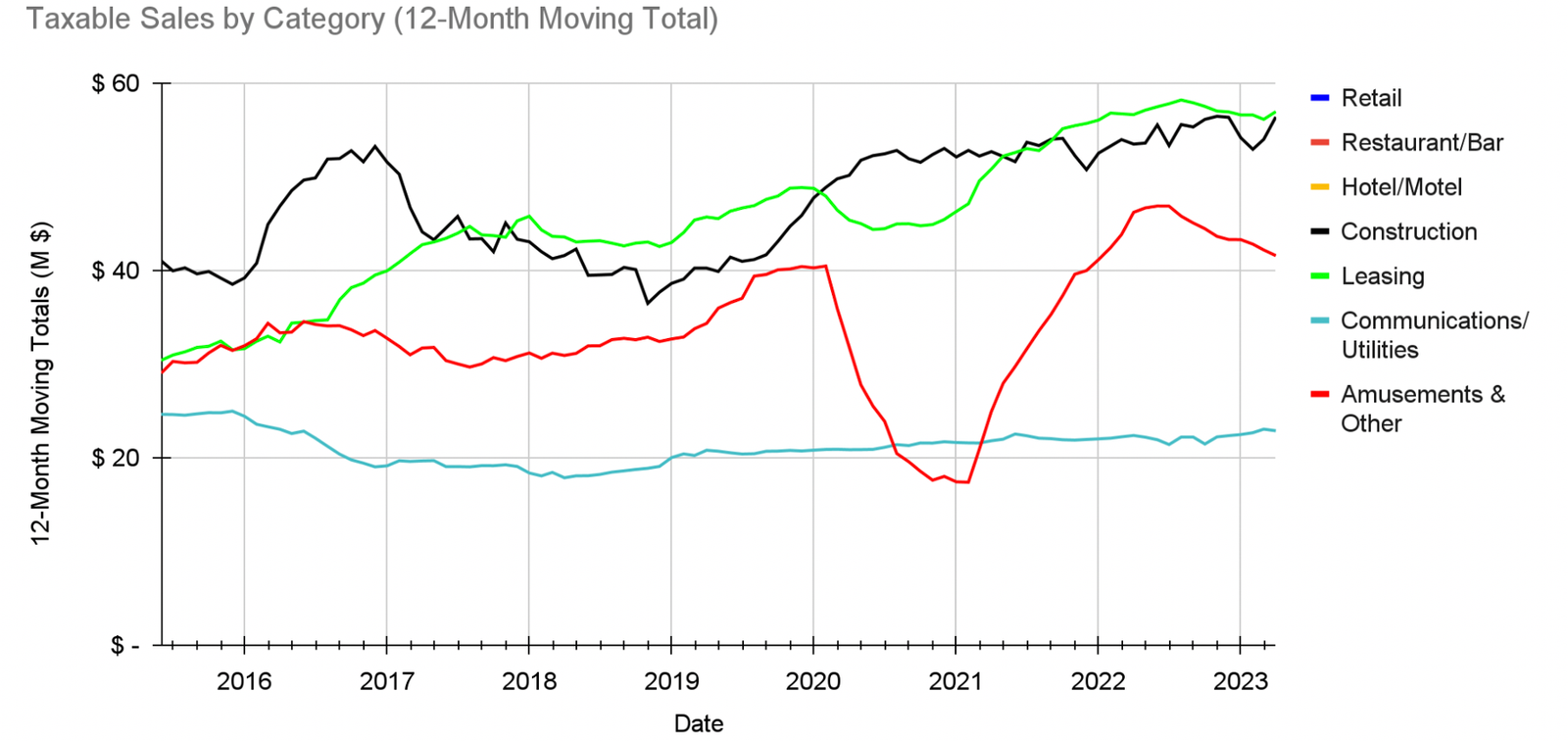
- Construction – This category is remarkably flat given the amount of construction in town with a post pandemic increase. However, it should be remembered that after the building boom in the early 2000s and the bust in 2008 there are limited numbers of vacant building sites in the community, and much of the construction activity is likely related to rehabs and moving existing homes into the STR marketplace.
- Leasing – Leasing costs have almost doubled in the past 7 years. Anecdotally, members of the business community and renters have commented that the costs of leases have greatly increased over the past few years given the pressure of STRs. Higher leases for businesses in town may also make retail less profitable and require charging higher rates for goods.
- Communications/Utilities – These sales have been steady over this period.
- Amusements & Other – This category saw the most variability with a large drop over the pandemic year, but with a significant recovery post pandemic when everyone wanted to get out and see the country. Clearly the Jeep tours, trolley tours, van tours and OHVs have seen a significant increase in use by visitors, but likely not by residents.This category has shown a reduction in the past year.
To summarize these increases, the following graphs show how these different categories have increased over the past 7 years:

These graphs show that over the past 7 years, Hotel/Motel in traditional lodging and STRs has increased fourfold in terms of gross sales. This relates to an over 40% annual increase in lodging in Sedona over this 7 year timeframe, in spite of the pandemic. Both Retail and Restaurant/Bar have also increased, but at about half this rate. Leasing shows annual increases of almost 20% annually, which is significant. If a local recession takes hold, this could cause businesses to fail and result in a depressive effect on lease rates.
Overall all categories of taxable sales increased about 20% per year over this period, compared to an annual inflation rate of about 3% over the same period. It is a valid question as to whether this type of growth is sustainable or healthy for Sedona given the constraints of transportation and affordable housing.
Traditional Lodging Growth
While reviewing taxable sales in Sedona is useful, it is also important to review the changes in the use and cost of lodging in Sedona. The following graphs present the information on the monthly occupancy and Average Daily Rate (ADR) charged for lodging in Sedona using numbers provided by the Sedona Chamber of Commerce. These graphs show 12-month moving averages (as opposed to moving totals) for these two parameters as well.
The first graph shows that lodging occupancy drops slightly over each summer with a larger drop during the winter months. The 12-month moving average shows a much more consistent yearly occupancy that runs between 60% and 70%. Notably, occupancy dropped after the 2008 financial crisis and also the pandemic. The occupancy rate has continued to trend slightly downward in the past year.
The second graph shows that ADR has for many years shown steady increases with a limited range in this nightly rate in earlier years. However, post pandemic the ADR has significantly increased, tailing off slightly in the past year. Since the pandemic the ADR significantly increased from less than $250/night to almost $350/night 2 years later. These higher ADRs have likely been a contributor to the higher Hotel/Motel category sales increases noted earlier. These lodging sales gains have remained steady over the past 2 years. One conclusion could be that the local lodging providers have found they have been able to increase rates without substantially reducing occupancy.

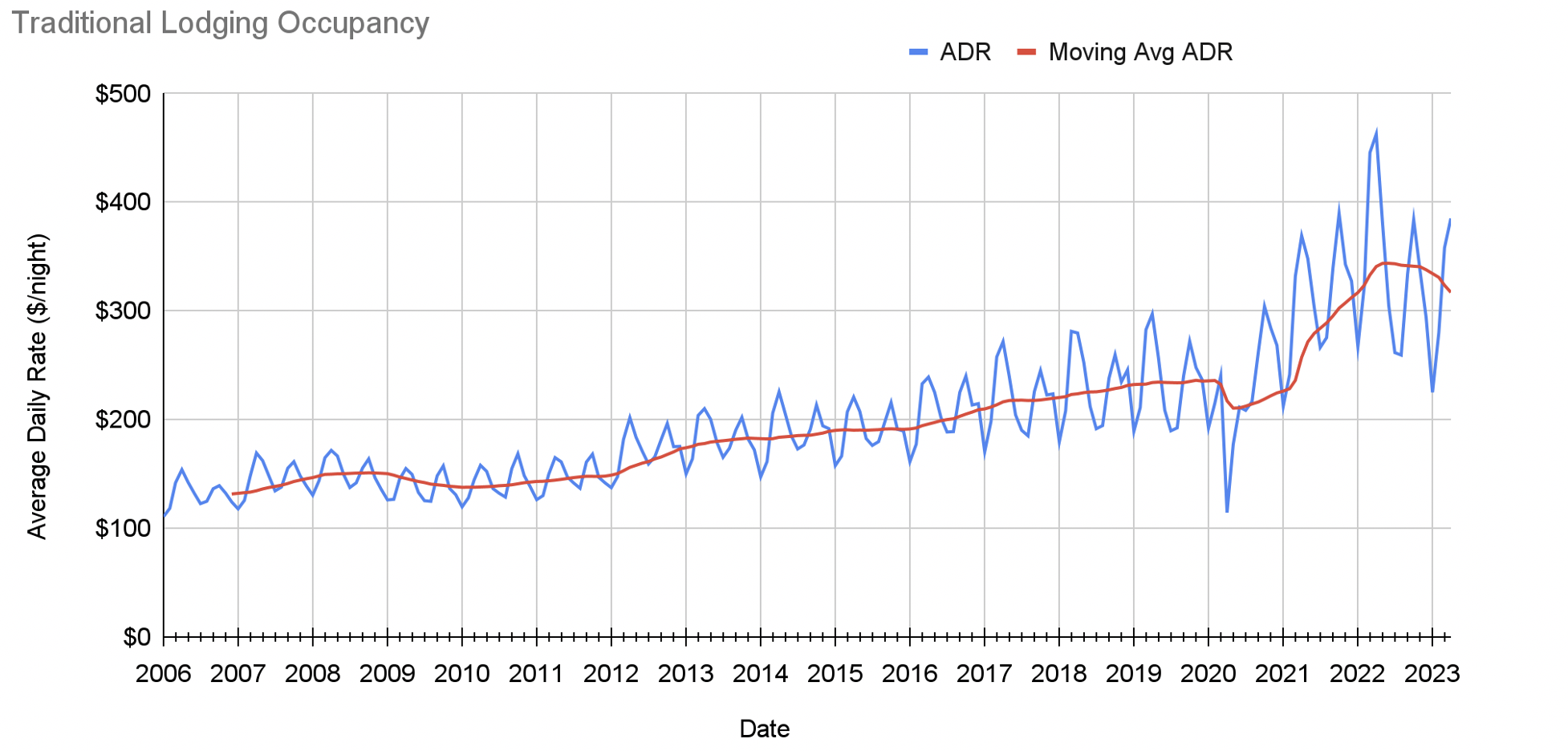
Economic Impact of STRs in Sedona
The number of STRs in Sedona continues to increase. The following graph shows the current inventory and historical numbers of STR units going back 3 years. The use of STRs really took off once the Arizona legislature limited local control of STRs in 2016. Sales and Bed taxes from STRs soon followed this change.
This graph also includes an estimate of the equivalent number of rooms for the whole house and single room STR rentals available in Sedona, which is approaching 2,500 rooms compared to 1,827 traditional lodging rooms in town. STRs now represent about 57% of the equivalent hotel rooms in Sedona. This graph shows that the largest increase in STRs is in the provision of whole house STR rentals.

So how much of the Hotel/Motel taxable sales category is generated by traditional lodging and how much by STR rentals? The graph provided below provides some insight into this question.
 The blue area is the estimate of the 12-month moving total sales for traditional lodging. The monthly estimate of traditional lodging sales is calculated using the product of the available lodging rooms in Sedona, the average occupancy rate, and the ADR noted earlier to then calculate the 12-month moving totals for traditional lodging. The red line presents the sales tax based sales using the Hotel/Motel sales tax values from 2007 to today.
The blue area is the estimate of the 12-month moving total sales for traditional lodging. The monthly estimate of traditional lodging sales is calculated using the product of the available lodging rooms in Sedona, the average occupancy rate, and the ADR noted earlier to then calculate the 12-month moving totals for traditional lodging. The red line presents the sales tax based sales using the Hotel/Motel sales tax values from 2007 to today.
It is evident from the plot that the calculated Hotel/Motel sales using sales taxes and those from the traditional lodging sales estimate are essentially the same until around early 2017. The difference between these two totals is likely the gross sales generated by STRs operating within Sedona. From the graph this indicates that over 47% of the overall lodging sales in Sedona could be due to STRs.
It should also be noted that since the occupancy and ADR for the traditional lodging sales estimate come from a Chamber sample of less than a third of these establishments, traditional lodging could be generating more sales if these two numbers provided are lower than the actual room weighted averages for all the lodging establishments.
The graph also shows that if true, there has been continued significant growth of the STR category post pandemic with an estimated reduction in traditional lodging sales. It is clear that this division of sales in these two categories needs to be watched carefully.
Grocery Sales
There is no direct way to gather actual grocery sales in Sedona so these sales must be estimated. While Sedona has a permanent population of 9,763 residents, there are also a fair number of part time residents and we also know that the renters of STRs and Time-Shares purchase food during their stays in town.
It is hard to provide any type of accurate estimate of these visitor grocery purchases, so an estimate of only the full time resident sales is provided using the full time population times $300 per month per resident. The grocery sales estimate is $2.9 Million in grocery sales per month, or about $35 Million annually. This is likely a low estimate for this non-taxable category.
Fuel Sales
Sedona has five gas stations providing fuel to residents and visitors alike. They also are used for refueling many of the local Jeep, ATV, and shuttle operations. The following graph is based on data from the US Energy Administration between 2014 and present on the national average cost of regular fuel each month. There is clearly a lower value during the pandemic and a higher value post pandemic during the summer of 2022.
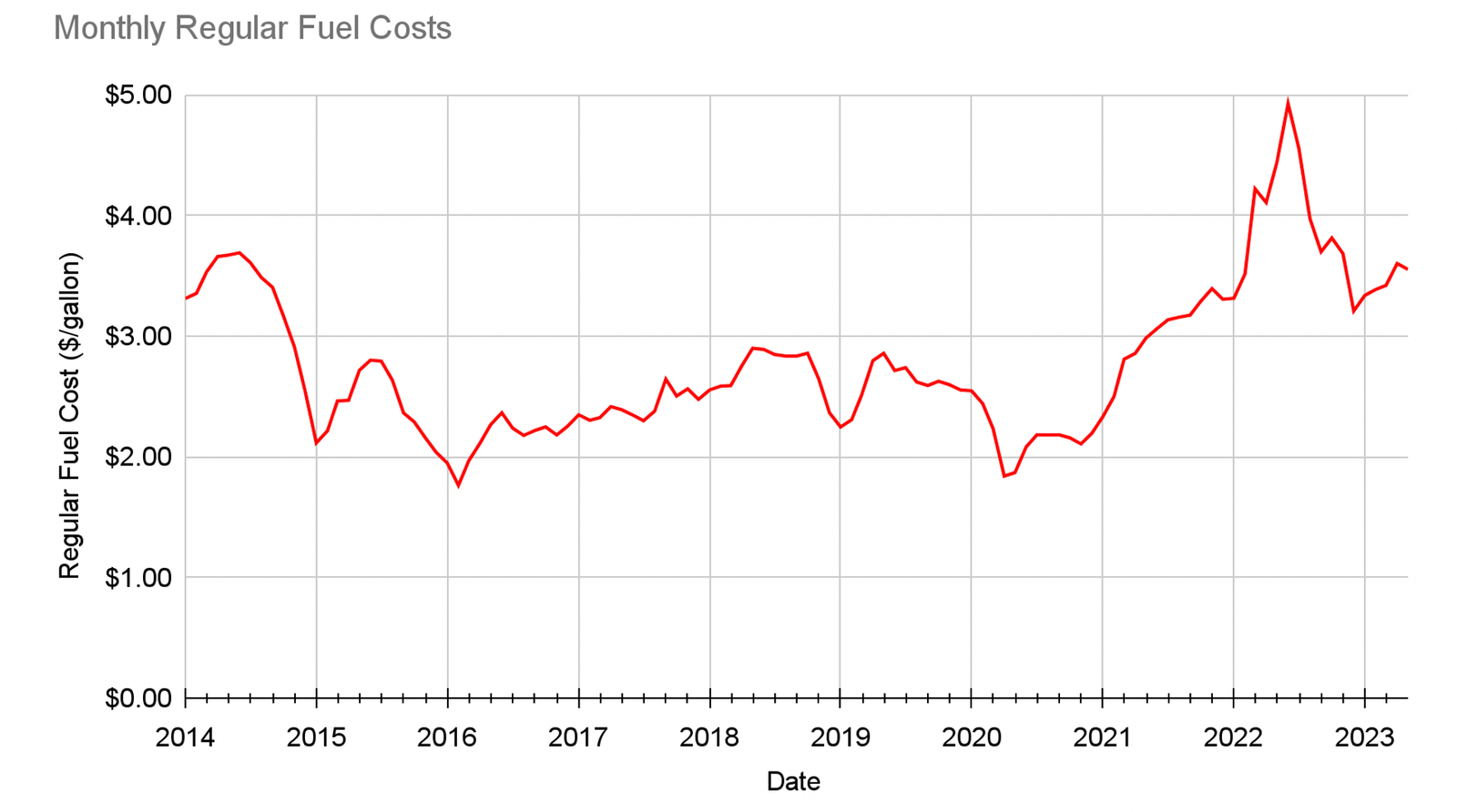
Given that the average gas station sells 4,000 gallons of fuel daily, this could be used to provide a rough estimate of fuel sales in Sedona, recognizing that changes in visitation would have an impact on this tally. The following graph shows a 12-Month moving total for these estimated fuel sales in Sedona using the fuel cost rates shown in the graph above.
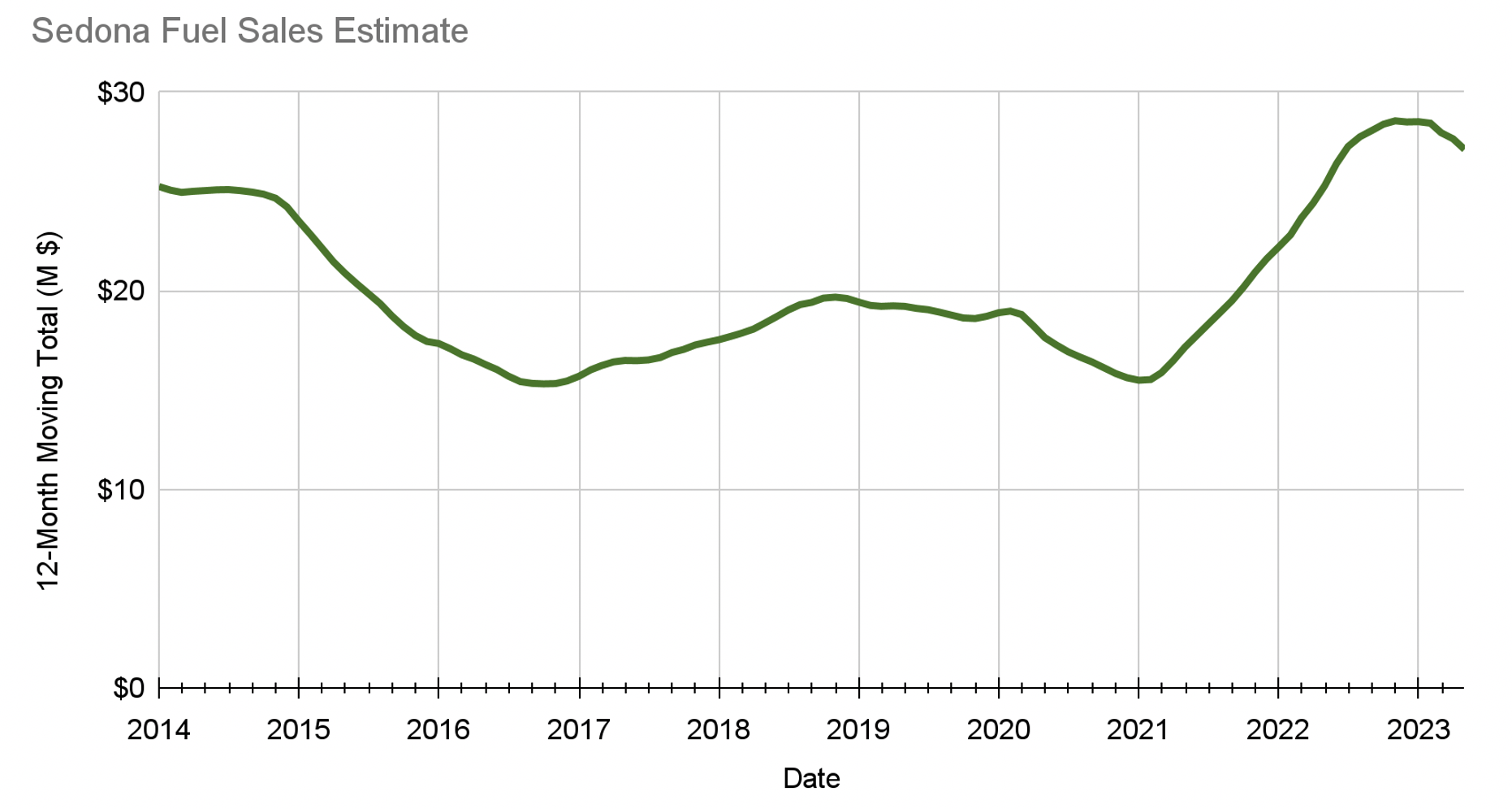
This graphic shows that the contribution to the local economy may range from $15 million to almost $30 million annually depending solely on variation in the price of fuel. There is clearly a significant amount of uncertainty in this estimate given the high variability in visitation to the area and the need for fuel for such things as visitor, jeep, trolley, shuttle and ATV use in the Sedona area. Since fuel is usually not something that most gas stations make much profit on, associated convenience store sales are much more important to them and these sales are reflected in the Retail sales category.
Real Estate Sales
Sedona has real estate that is on the high end for the US and is in a desirable community that has limited land for building new homes and businesses. Given the high cost of real estate, the community is also subject to boom and bust conditions since it is primarily a tourism economy that is contingent on visitors having disposable income to participate.
While some economic analyses such as the Gross National Product (GNP) only evaluate the sale of properties with new structures, this analysis will evaluate the real estate sales of all types of property. Since detailed data is also not available prior to 2019 for different real estate types the following graphic is provided to show the total real estate sales in Sedona available from both Yavapai and Coconino counties from 2015 to present on a monthly basis and as a 12-month running total.
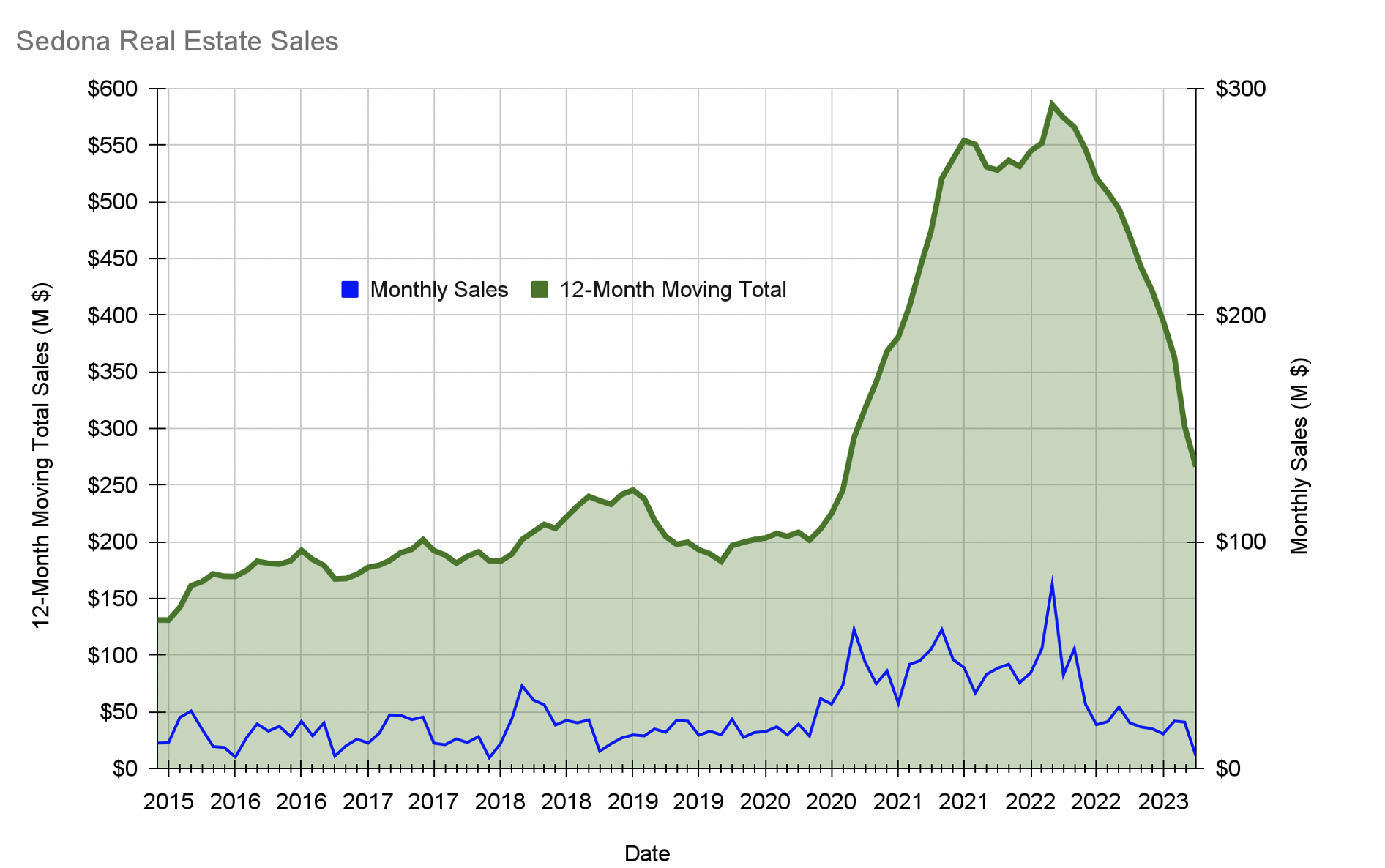
From this graphic, it is clear that while we had a significant real estate market of about $200 million per year prior to the pandemic, the large increase in sales that took place post pandemic was likely due to the increase in visitation and the speculative market in STRs that increased the annual sales to almost $600 million per year. Real estate sales have since cooled down and are approaching the real estate market pre-pandemic. Some would say that this market boom is similar to the pre 2008 market boom (and subsequent bust) in Sedona.
To look at the mix of real estate sales as vacant land, single family, multifamily, government owned and commercial properties on an annual basis the following graph shows these categories for the past 5 years. This includes sales in Sedona for both Yavapai and Coconino counties.
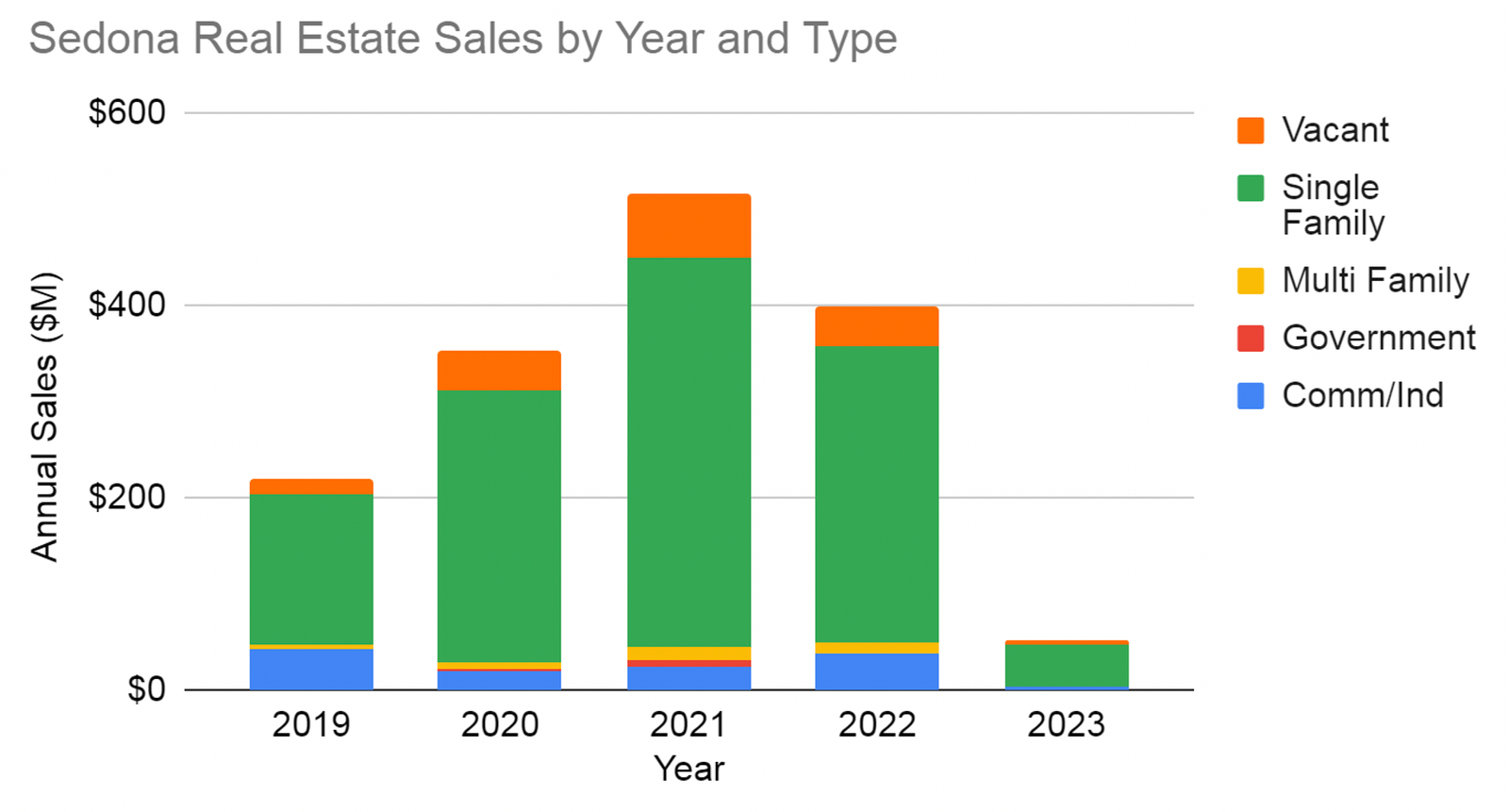
This comparison shows that pre and post pandemic, these real estate sales were based largely on the sale of vacant land and single family properties. The sale of multi-family properties and government owned properties was relatively small by comparison. It can also be seen that pre pandemic sales of commercial/Industrial properties actually exceeded the sales of those types of properties since.
Total Sedona Economy
As noted at the outset, this analysis is primarily focused on where the economy has been, where it is and the most recent trends by different types of sales categories. It does not make any predictions going forward that may be impacted by national or international events or economic policy.
The following graph combines all of the taxable sales categories along with the non-taxed grocery, fuel and real estate sales through April of 2023. Note that grocery and fuel were estimated with a fair amount of uncertainty, but are included for context. No attempt has been made to estimate health care sales in the community.
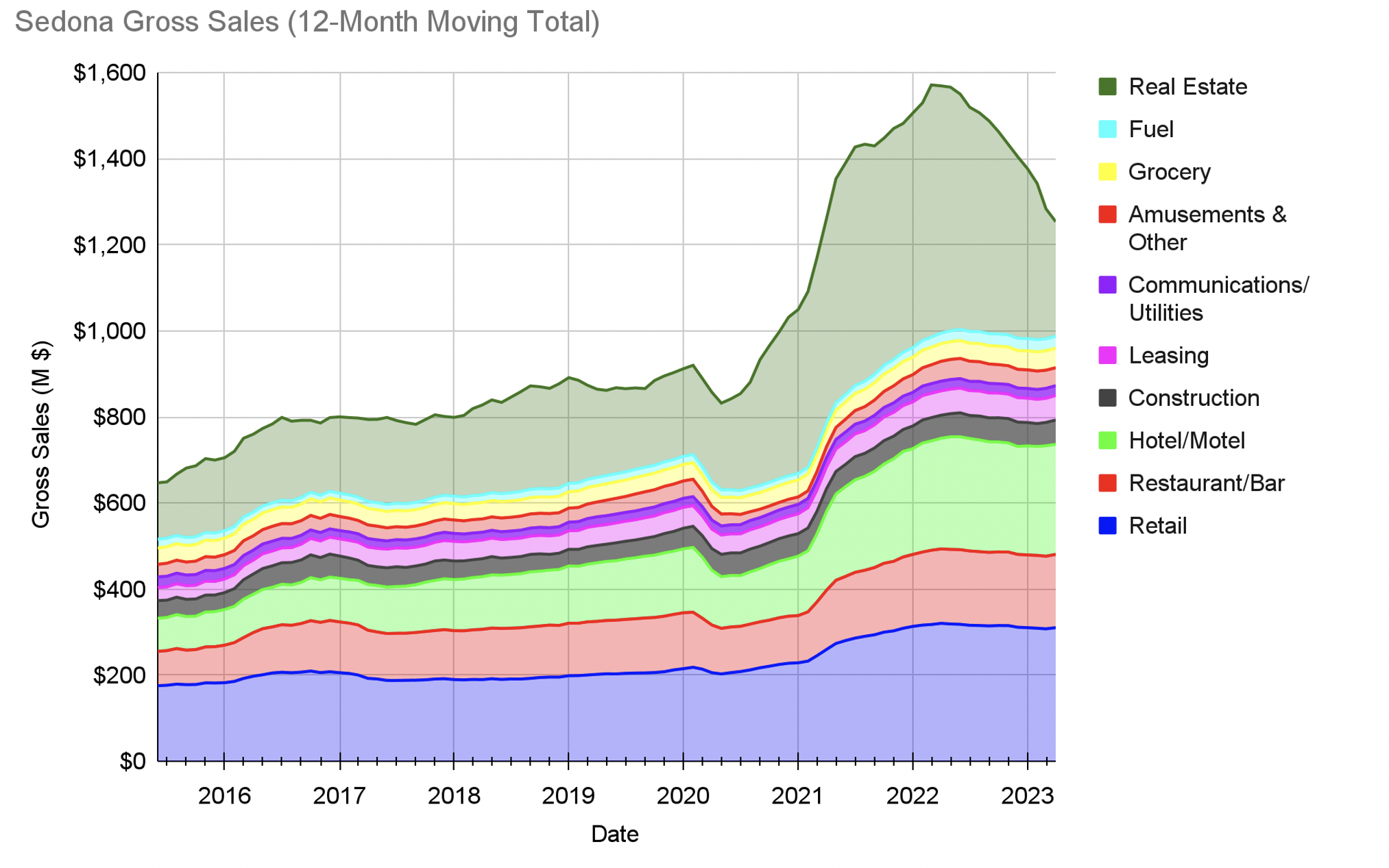
This chart suggests that the local economy has increased significantly since before the pandemic in terms of dollar value. Note that this estimate shows a local economy of about $900 million in 2019 that has increased to $1,250 currently, an almost 40% increase in that 4 year period.
In addition, the local economy peaked in early 2022 when it reached almost $1.6 billion, largely due to the real estate boom of 2021-2022. This huge increase has since dropped due to the post pandemic real estate market correction.
Increases in Retail sales post pandemic lead the way with Hotel/Motel(STR) also showing significant increases while Restaurant/Bar had modest increases. The other taxable categories are showing modest increases. As noted earlier, it is important to look at longer term trends and not depend on comparisons to the prior year for a particular month given the economic disruption that the entire country experienced over the past few years.
To look at the past year in more detail, the following table is provided:
Table 1 – 12-Month Moving Total of Sales (Millions of $) by Category
| Date | Retail | Rest/Bar | Hotel/ Motel | Constr. | Leasing | Comm/ Utilities | Amuse./ Other | Real Estate |
| Apr 2022 | $320.4 | $172.8 | $257.3 | $53.5 | $56.6 | $22.4 | $46.2 | $574.4 |
| May 2022 | $319.0 | $173.2 | $261.7 | $53.6 | $57.1 | $22.2 | $46.7 | $566.0 |
| Jun 2022 | $318.1 | $173.5 | $262.3 | $55.5 | $57.5 | $21.9 | $46.9 | $546.2 |
| Jul 2022 | $315.9 | $172.7 | $261.4 | $53.3 | $57.8 | $21.4 | $46.9 | $521.0 |
| Aug 2022 | $315.3 | $171.6 | $259.6 | $55.6 | $58.2 | $22.2 | $45.8 | $508.4 |
| Sep 2022 | $314.5 | $170.9 | $257.1 | $55.3 | $57.9 | $22.2 | $45.1 | $494.0 |
| Oct 2022 | $315.3 | $171.1 | $255.6 | $56.1 | $57.5 | $21.5 | $44.5 | $469.9 |
| Nov 2022 | $315.2 | $170.9 | $253.6 | $56.5 | $57.0 | $22.2 | $43.6 | $442.2 |
| Dec 2022 | $311.3 | $169.2 | $251.0 | $56.3 | $56.9 | $22.4 | $43.3 | $421.9 |
| Jan 2023 | $310.3 | $169.0 | $253.6 | $54.2 | $56.6 | $22.5 | $43.3 | $394.9 |
| Feb 2023 | $309.0 | $169.2 | $253.3 | $52.9 | $56.6 | $22.7 | $42.8 | $362.8 |
| Mar 2023 | $307.6 | $168.7 | $256.8 | $54.0 | $56.1 | $23.1 | $42.2 | $302.1 |
| Apr 2023 | $310.3 | $170.2 | $255.9 | $56.4 | $56.9 | $22.9 | $41.6 | $266.4 |
| 1-Year Change | -3.2% | -1.5% | -0.5% | 5.4% | 0.6% | 2.2% | -10.0% | -53.6% |
This table shows that the past year has seen a slight reduction in sales but these reductions come on the heels of an all-time peak of sales in spring of 2022 in the tourism focused categories of Retail, Restaurant/Bar, and Hotel/Motel. The categories of Construction, Leasing, and Communications/Utilities all had modest increases in sales. The Amusement/Other category showed a larger reduction and Real Estate experienced a significant reduction, again from an all time high.
From this table it appears that Sedona is simply following the entire country in a reduction in economic activity that is inevitable following the extraordinary events of 2021 and 2022. Employment rates and limited available labor force suggests that the local economy is not in a recession.
Inflationary Impacts
The last two years have been unique given the rapid changes with inflationary pressures. These were exhibited in many of the categories presented earlier. While this article is focused on the local economy, the following graph shows the Consumer Price Index (CPI) for the entire country using two different measures from the Federal Reserve (FED).
The CPI includes all items that individuals and businesses buy and tends to be a higher rate as this includes grocery and energy costs that are more volatile. The Core CPI includes durable goods that are not as influenced by inflation.
The FED stated goal is to modify their fiscal policy so that the CPI inflation rate is about 2%. The graph shows that the CPI held close to this rate, but has since increased after the disruption of the pandemic in 2020 and other international events.

You may notice that these curves look remarkably like the real estate curve shown earlier in this article. The recent reductions in the CPI are similar to the recent reductions in real estate sales values over the same time frame.
Conclusions
The above analysis highlights the fact that Sedona currently has a total economy of around $1.25 Billion annually based on taxable and non-taxable sales. With the available information shown in the paragraphs above we can draw the following general conclusions:
- The local Sedona economy did not keep pace with inflation from 2004 to 2013, but has significantly outstripped the national inflation rate from 2013 to present.
- The economy in Sedona has remained stable over the past year, while some would say that it remains overheated based on the comparison of 2019 to 2023 gross taxable sales.
- The growth of Hotel/Motel, Retail, and Restaurant/Bar sales categories has been very significant post Pandemic. This may be attributed to additional visitors from California and Phoenix needing a place they could drive to for a vacation, but the increase in tourism has remained high since travel restrictions to other areas of the US and outside the country have eased.
- Traditional lodging operators in Sedona have been able to significantly increase their ADR with only modest impacts on occupancy and significantly increasing their gross sales as a result.
- The increasing STR market appears to continue to rapidly increase in number and their share of the Hotel/Motel market in Sedona.
- The STR market may have fueled the significant increase in the local real estate market in 2021 and 2022, which seems to have stabilized over the past year.
- Sedona still needs to develop a vision of what the local economy should be so that it remains a livable city for its residents.
So is the Sedona Economy Healthy? It really depends on what vision the community has for itself. Is continued expansion and growth of the local economy good for Sedona? Can the local transportation infrastructure and trail systems manage continued increases in visitation sustainably?
Sedona went through a period of peak visitation during 2021 and 2022. Inflection points such as that can be helpful when envisioning what the community wants and does not want for its future. While it may not be a universal view, it is likely that residents and businesses alike want to see a balanced and sustainable economy that allows businesses to live in harmony with a thriving community of residents that enjoy and can afford to live here.
* The information used was gathered from the City of Sedona website documents and other documents provided by Sedona. The real estate information was gathered from sales information that Yavapai and Coconino Counties provided. Assistance by David Jakim in the records group at the City is appreciated.

Editor’s Note: Mark TenBroek is a retired Professional Civil Engineer who graduated from the University of Michigan in 1977 and worked as a consulting and design engineer in the Midwest for over 40 years. He worked primarily on Water and Wastewater projects for municipalities and utilities. Mark and his spouse arrived in Sedona in 2017 to design and build a home in Uptown where they now live. He understands Sedona’s unique place as both a sacred and spiritual center. Researching how the local economy can be effectively managed to protect our quality of life, the natural world, the tourist experience, and reasonable profits for local businesses, has become his passion.




